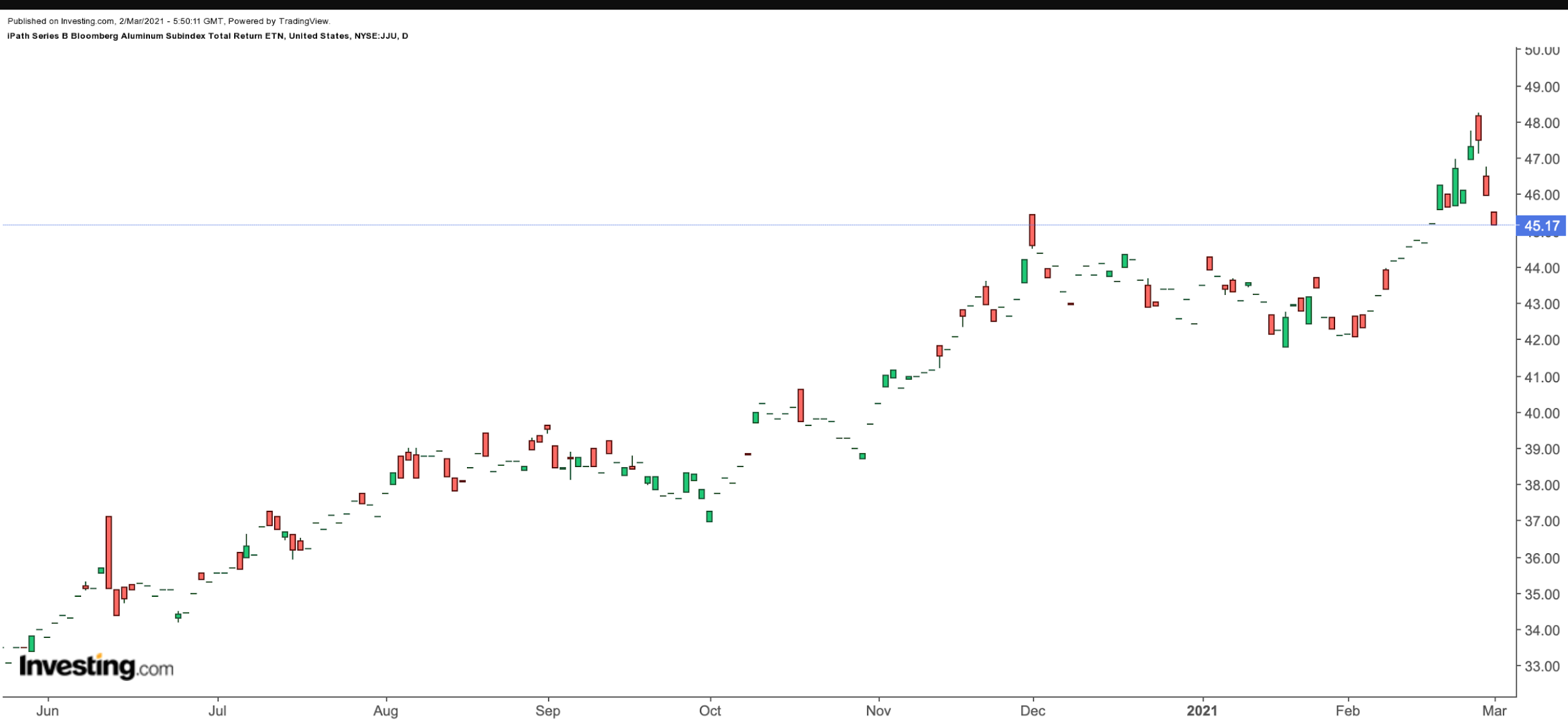Recently we discussed the Invesco DB Base Metals Fund (NYSE:DBB), a futures-based commodity fund, focusing on aluminum, copper and zinc. Today, we focus in on one of those base metals—aluminum, as well as another exchange-traded product that could appeal to readers who are bullish on aluminum.
Over the past year, the Dow Jones Aluminum Index is up over 85%. Year-to-date (YTD), it returned about 6% and hit a 52-week high on Feb. 25, when equities across the board, especially tech shares, declined.

Although it is one of the most abundant elements, pure aluminum is very reactive and is not found in free form in nature. Instead, it is part of other minerals, mainly bauxite, the primary source of aluminum.
Bauxite ore "must first be chemically processed to produce alumina (aluminum oxide). Alumina is then smelted using an electrolysis process to produce pure aluminum metal. Bauxite is typically found in topsoil in various tropical and subtropical regions. Bauxite reserves are most plentiful in Africa, Oceania and South America. Reserves are projected to last for centuries."
In terms of global aluminum production, China leads the list of nations. Next in line are India, Russia and Canada. Recent metrics highlight aluminum consumption is expected to reach 70.8 million metric tonnes in 2023. In 2016, it was 58 million metric tonnes.
A survey by S&P Global summarizes:
"Aluminum will remain profitable for Chinese smelters in the coming years as prices are expected to hover at prevailing highs."
Uses Of Aluminum Alloys
The use of aluminum extends to cans, foils, kitchen utensils, window frames, beer kegs and airplane parts. Aluminium is a good electrical conductor and is often used in electrical transmission lines. It is cheaper than copper and weight for weight is almost twice as good a conductor.
In fact, the automotive and transportation industries rely heavily on aluminum. For instance, those readers who have flown Boeing's (NYSE:BA) 747 might be interested to know that "147,000 pounds (66,150 kg) of high-strength aluminium is used in its construction."
Before we move to our fund for today, let's also highlight several individual stocks that produce the commodity. They include:
- Alcoa Corp (NYSE:AA) – up 85.1% in 12 months;
- Aluminum Corp of China (NYSE:ACH) – up 86.0% in 12 months;
- Arconic Corp (NYSE:ARNC) – up 227.5% since April 2020 (the company is a spin-off from Arconic Inc.
- Century Aluminum (NASDAQ:CENX) (NASDAQ:CENX) – up 147.7% in 12 months;
- Kaiser Aluminum (NASDAQ:NASDAQ:KALU) – up 24.8% in 12 months.
Put another way, despite the differences in returns, shareholders in these aluminum companies have had a robust 12-month period.
Barclays iPath Bloomberg Aluminum Subindex Total Return
Current price: $45.17
52-week range: $32.18 - $48.26
Expense ratio: 0.45% per year
The iPath Series B Bloomberg Aluminum Subindex Total Return ETN (NYSE:JJU)) is an exchange-traded note (ETN). It tracks the Dow Jones-UBS Aluminum Subindex Total Return, a single-commodity index with one futures contract on aluminum.

ETNs are unsecured debt obligations of the issuer, namely Barclays (LON:BARC) (NYSE:BCS) in the case of JJU. We previously discussed ETNs, with an emphasis on how they differ from exchange-traded funds (ETFs). Therefore, readers might also want to review that article. ETNs may not be suitable for all investors.
In the US, JJU is currently the only exchange-traded product (ETP) tracking aluminum futures. This means there is no physically-backed ETF for aluminum. Similarly, no ETF focuses mainly on aluminum companies. However, given the recent interest in the metal, this might change in the future.
Over the past year, it returned more than 20%. Aluminum bulls whose risk/return profiles allow for investing in an ETN might want to keep the fund on their radar. Alternatively, one or several of the aluminum stocks we mentioned could also deserve further due diligence. Long-term, we are bullish on the metal.
